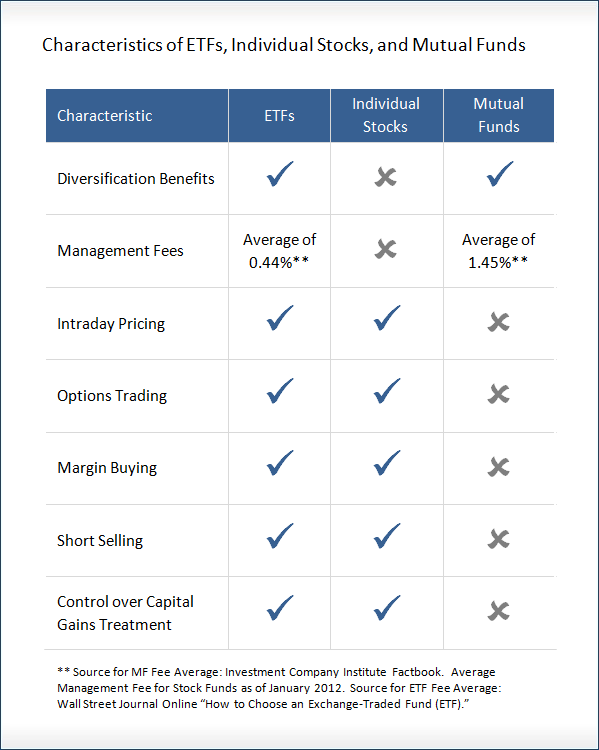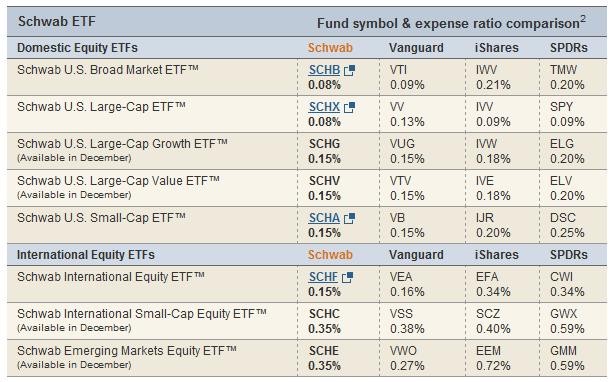ETFs v Funds Which Is the Right Choice
Post on: 4 Июль, 2015 No Comment

Key Points
- ETFs are not for everyone. Before you leap, consider what they are—and whether they’re really right for you. Look at situations where mutual funds might be a better option. Ideas for ETFs and mutual funds to consider.
It’s hard to flip through a financial publication without being bombarded by ads for exchange-traded funds. But despite all the publicity, ETFs are not for everyone. Before you leap, consider what they are—and whether they’re really right for you. Below are some guidelines to consider when evaluating ETFs vs. mutual funds.
What’s an ETF?
ETFs are essentially securities that track an index, a commodity or a basket of assets like an index fund, but trade like stocks on an exchange. When you buy an ETF, you own a single security that represents a basket of other securities, which generally tracks an index and fluctuates with the value of the underlying assets.
But there are key differences: One of the biggest is how you make your investment.
With an ETF, you place an order to buy or sell shares just as with any stock—and you typically pay a commission on that trade. This means you can buy an ETF at its current price anytime during the trading day (though you will need to be sensitive to the cost of the ETF’s bid/ask spread and pay attention to the ETF’s price relative to its net asset value, or NAV). In contrast, you can only buy a mutual fund at the closing price.
ETFs also tend to be more tax-efficient than mutual funds. One example is the oldest ETF, the S&P 500 Depositary Receipt (SPY). Often abbreviated as SPDR and pronounced spider, it only made capital gains distributions in two of its first 19 years of existence.
How did the largest three S&P 500® index mutual funds distribute capital gains during that same 19-year time period? Vanguard made capital gains distributions in five of those years. Fidelity and T. Rowe Price each made capital gains distributions in seven of those years.
For investors who are focused on transparency, ETFs are typically more transparent than mutual funds, too. With most ETFs, the details of every security in the fund are published daily on the ETF company’s web site. For most mutual funds, the securities they own are only revealed four times per year, usually with a lag of about a month. If knowing the details of what you own is important to you, an ETF may be attractive.

Another potential advantage of ETFs is that they’re not required to keep cash on hand for redemptions, unlike mutual funds. And while a small amount of cash may actually improve results in a down market, it generally dampens returns.
When are ETFs right for you?
Here are smart ways you might use ETFs in your portfolio:
- Investing a large amount of cash in an index. If you’re looking to make a big long-term investment in US stocks, you might want to research and consider a low-cost, broad-market ETF.
- Getting exposure to a sector or asset class at a relatively low cost. If you’re building a diversified portfolio of stocks or mutual funds, ETFs can help you fill in the gaps or help implement a tactical asset allocation. For instance, if you want health care exposure, you may want to consider a health care sector ETF.
- Putting excess cash to work. Institutional investors use ETFs to equitize their cash—to put excess cash into stocks that can be converted back easily. Putting cash into a liquid ETF may make sense while you wait for an attractive investment opportunity. ETFs don’t have short-term redemption fees like many no-load funds (though commissions may still apply).
When might mutual funds be better?
Here are situations where ETFs might not be the best option:
- Investing small amounts of money at a time. If you’re investing a small amount of cash, a mutual fund (assuming you meet the minimum investment requirement) is often a better choice than an ETF simply because of commissions—the downside to the stock-like nature of ETFs. With a no-transaction-fee mutual fund, it costs you nothing to deposit more cash into the fund, but with most ETFs, you have to pay a commission every time you buy or sell. However, some ETFs are available commission-free at some brokerages—these ETFs may also be attractive for investing small amounts of money.
- Seeking an index-beating return. If you’re searching for a manager who tries to find hidden gems and deliver better returns than an index, you might not want to consider an ETF. Nearly all ETFs aim to match an index, meaning you’ll tend to get the index return less expenses, never more. A good actively managed mutual fund may be able to outperform the market (though the active fund is likely to have higher management fees). While there are some active and quasi-active ETFs, there are far more choices among mutual funds.
- Keeping trading simple. While some investors value the trading flexibility of ETFs and want to be able to trade any time during market hours, other investors prefer not to worry about bid-ask spreads or whether their trade will be executed at a price close to the fund’s underlying net asset value (NAV). For investors who don’t want to worry about these issues, mutual funds might make more sense.














